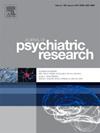轮班工人的脆弱性、感知和压力体验
IF 3.7
2区 医学
Q1 PSYCHIATRY
引用次数: 0
摘要
目的本研究旨在探讨倒班工作者和非倒班工作者的压力易感性、感知压力和压力体验,以及它们与睡眠、情绪和工作环境的关系。方法对4561名社会服务人员和2093名新州服务人员进行在线自我报告调查。参与者完成了压力脆弱性量表(SVS)、感知压力量表(PSS)、近期压力总体评估量表(GARS)、流行病学研究中心抑郁量表(CES-D)、匹兹堡睡眠质量指数(PSQI)和韩国职业压力量表(KOSS)。结果经年龄、性别、收入、教育程度、工作时间和职业等因素调整后,ssw的SVS、PSS和GARS得分均高于nsw。SWs和NSWs在额外调整PSQI或KOSS后,SVS和PSS无显著差异。另外调整CES-D后,SVS组间无差异,但PSS组间差异有统计学意义。在额外调整PSQI、KOSS或CES-D后,GARS的组间差异仍然显著。PSQI与GARS、KOSS与PSS之间的相关性在SWs中强于NSWs。结论与nsw相比,ssw表现出更大的压力易感性、更高的感知压力水平和更频繁的压力体验。SWs的压力易感性和感知压力增加与睡眠和工作环境有关。与新南威尔士州相比,睡眠和压力经历以及工作环境和感知压力之间的联系更为突出。本文章由计算机程序翻译,如有差异,请以英文原文为准。
Vulnerability, perception, and experiences of stress in shift workers
Objective
This study aimed to explore stress vulnerability, perceived stress, and stressful experiences of shift workers (SWs) and non-shift workers (NSWs) and their association with sleep, mood, and workplace environments.
Methods
An online self-reported survey was conducted which included 4561 SWs and 2093 NSWs. Participants completed the Stress Vulnerability Scale (SVS), Perceived Stress Scale (PSS), Global Assessment of Recent Stress (GARS) scale, short form of the Center for Epidemiologic Studies Depression Scale (CES-D), Pittsburgh Sleep Quality Index (PSQI), and Korean Occupational Stress Scale (KOSS).
Results
SWs demonstrated higher SVS, PSS, and GARS scores than NSWs after adjusting for age, gender, income, education, working hours, and occupations. SWs and NSWs showed no significant differences in SVS and PSS after additionally adjusting for PSQI or KOSS. SVS demonstrated no between-group differences when CES-D was additionally adjusted, but a significant difference remained in PSS. Between-group differences in GARS remained significant after additionally adjusting for PSQI, KOSS, or CES-D. The association between PSQI and GARS and between KOSS and PSS was stronger in SWs than in NSWs.
Conclusions
SWs demonstrated greater vulnerability to stress, higher perceived stress levels, and more frequent stressful experiences compared to NSWs. Increased stress vulnerability and perceived stress in SWs were associated with sleep and workplace environments. SWs showed a more prominent association between sleep and stressful experiences and between workplace environments and perceived stress than NSWs.
求助全文
通过发布文献求助,成功后即可免费获取论文全文。
去求助
来源期刊

Journal of psychiatric research
医学-精神病学
CiteScore
7.30
自引率
2.10%
发文量
622
审稿时长
130 days
期刊介绍:
Founded in 1961 to report on the latest work in psychiatry and cognate disciplines, the Journal of Psychiatric Research is dedicated to innovative and timely studies of four important areas of research:
(1) clinical studies of all disciplines relating to psychiatric illness, as well as normal human behaviour, including biochemical, physiological, genetic, environmental, social, psychological and epidemiological factors;
(2) basic studies pertaining to psychiatry in such fields as neuropsychopharmacology, neuroendocrinology, electrophysiology, genetics, experimental psychology and epidemiology;
(3) the growing application of clinical laboratory techniques in psychiatry, including imagery and spectroscopy of the brain, molecular biology and computer sciences;
 求助内容:
求助内容: 应助结果提醒方式:
应助结果提醒方式:


